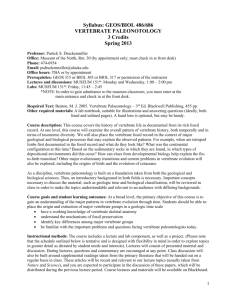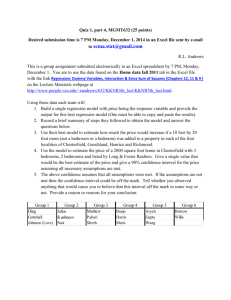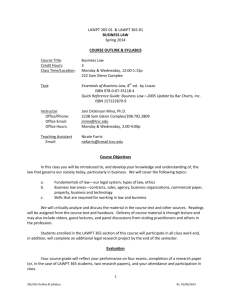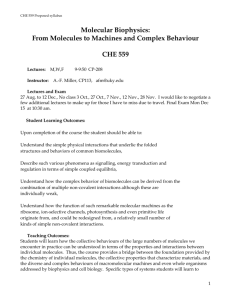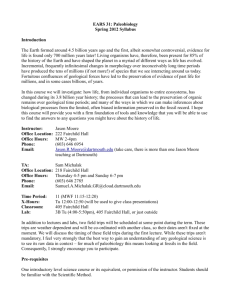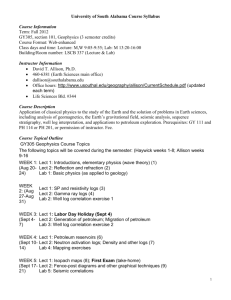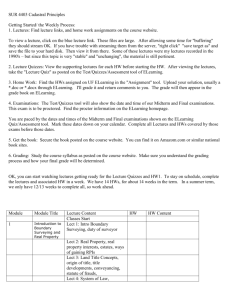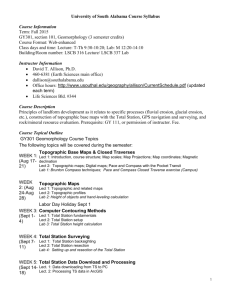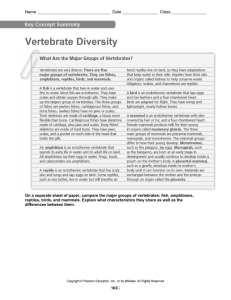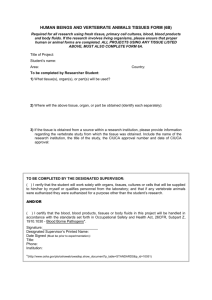The history of vertebrate evolution is a fascinating
advertisement
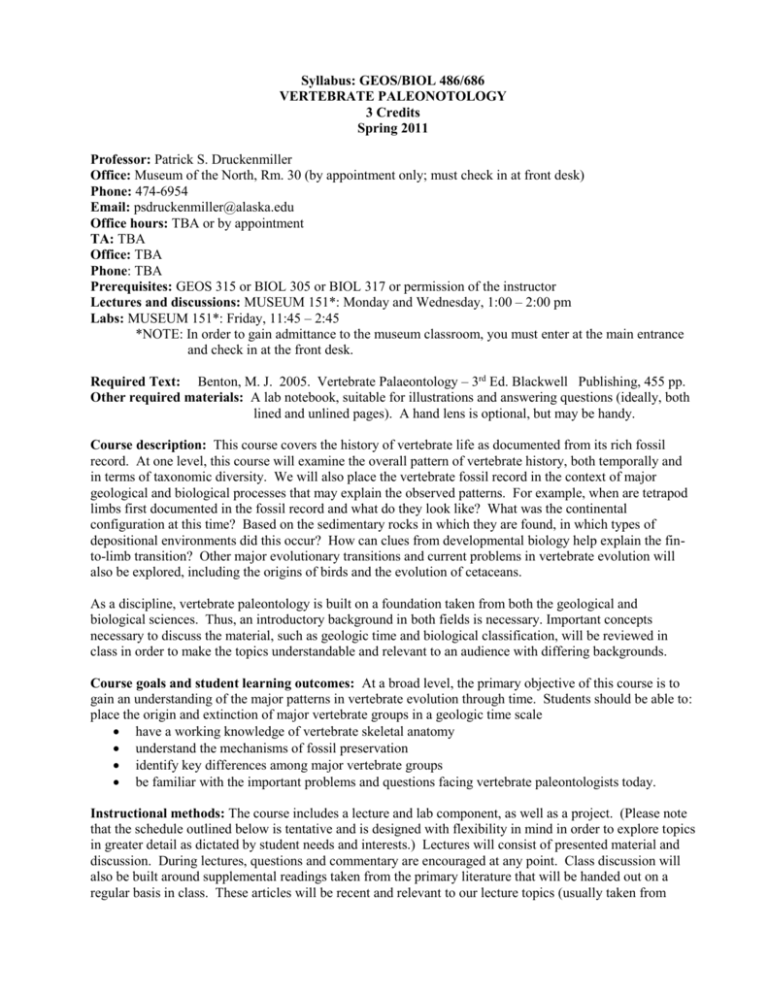
Syllabus: GEOS/BIOL 486/686 VERTEBRATE PALEONOTOLOGY 3 Credits Spring 2011 Professor: Patrick S. Druckenmiller Office: Museum of the North, Rm. 30 (by appointment only; must check in at front desk) Phone: 474-6954 Email: psdruckenmiller@alaska.edu Office hours: TBA or by appointment TA: TBA Office: TBA Phone: TBA Prerequisites: GEOS 315 or BIOL 305 or BIOL 317 or permission of the instructor Lectures and discussions: MUSEUM 151*: Monday and Wednesday, 1:00 – 2:00 pm Labs: MUSEUM 151*: Friday, 11:45 – 2:45 *NOTE: In order to gain admittance to the museum classroom, you must enter at the main entrance and check in at the front desk. Required Text: Benton, M. J. 2005. Vertebrate Palaeontology – 3rd Ed. Blackwell Publishing, 455 pp. Other required materials: A lab notebook, suitable for illustrations and answering questions (ideally, both lined and unlined pages). A hand lens is optional, but may be handy. Course description: This course covers the history of vertebrate life as documented from its rich fossil record. At one level, this course will examine the overall pattern of vertebrate history, both temporally and in terms of taxonomic diversity. We will also place the vertebrate fossil record in the context of major geological and biological processes that may explain the observed patterns. For example, when are tetrapod limbs first documented in the fossil record and what do they look like? What was the continental configuration at this time? Based on the sedimentary rocks in which they are found, in which types of depositional environments did this occur? How can clues from developmental biology help explain the finto-limb transition? Other major evolutionary transitions and current problems in vertebrate evolution will also be explored, including the origins of birds and the evolution of cetaceans. As a discipline, vertebrate paleontology is built on a foundation taken from both the geological and biological sciences. Thus, an introductory background in both fields is necessary. Important concepts necessary to discuss the material, such as geologic time and biological classification, will be reviewed in class in order to make the topics understandable and relevant to an audience with differing backgrounds. Course goals and student learning outcomes: At a broad level, the primary objective of this course is to gain an understanding of the major patterns in vertebrate evolution through time. Students should be able to: place the origin and extinction of major vertebrate groups in a geologic time scale have a working knowledge of vertebrate skeletal anatomy understand the mechanisms of fossil preservation identify key differences among major vertebrate groups be familiar with the important problems and questions facing vertebrate paleontologists today. Instructional methods: The course includes a lecture and lab component, as well as a project. (Please note that the schedule outlined below is tentative and is designed with flexibility in mind in order to explore topics in greater detail as dictated by student needs and interests.) Lectures will consist of presented material and discussion. During lectures, questions and commentary are encouraged at any point. Class discussion will also be built around supplemental readings taken from the primary literature that will be handed out on a regular basis in class. These articles will be recent and relevant to our lecture topics (usually taken from Nature and Science), and you are expected to participate in the discussion of these papers, which will be distributed during the previous lecture period. Labs are an integral part of this course, and are designed to provide students with an enjoyable and practical knowledge of fossil vertebrates. The primary aim of the labs is to gain hands-on experience identifying and familiarizing yourself with actual specimens, both real and cast. Handouts, consisting of key words, concepts, exercises, and illustrations will accompany each lab. An integral component to the labs will be your notebook; this is where you will make the requested illustrations, answer lab questions, a write observations and notes. These will be turned in at the end of each lab, and graded; the lab books will be returned in lecture. Notebook assignments constitute 20 percent of your total grade. Ultimately, it will become an important study guide for lab exams, as well as a useful reference even after the course has ended! A field trip to the Permafrost Tunnel will be made near the end of the semester to examine Pleistocene vertebrate material in situ. The field trip will occur during our scheduled lab time and will count as a regular lab for attendance and grading purposes. A class project is also required, which will be 20 percent of your total grade. Each student will help create a page on the UA Museum website detailing an aspect of Alaskan vertebrate paleontology. This topic might be on a particular taxon (e.g., American lions – Panthera atrox) or on the geologic context for a given fossil site (e.g., taphonomy of the Liscomb hadrosaur bone bed). Topics must be approved by the instructor and the content will include text, photographs, and relevant links. The site is intended to be “the” place to go for interested parties (the public, teachers, officials, researchers, etc…) to gather salient information on our state’s fossil resources. (Plus, your work will actually be useful to others, rather than just gathering dust on the professor’s shelf!). A sheet detailing the requirements for the project will be handed out in class. Course policies: Attendance in both lecture and lab is mandatory. For this reason, 5% of the total grade will be based on attendance and participation. Students missing no more that three hours of class time (one lab or three lectures) will receive an A for attendance, those missing 4-6 hours will receive a B, etc. I expect students to arrive in class on time, and repeated and/or excessive tardiness will be treated as non-attendance. Make-up exams are allowed for legitimate excuses (illness, attending a conference, etc...) and can be scheduled with the instructor. Students are expected to conform to student code of ethic, as outlined in the UAF catalog. Plagiarism and cheating will not be tolerated and will be dealt with seriously. Evaluation: Grading will be divided as follows: Lecture Exam 1: Lecture Exam 2: Final Lecture Exam: Lab Exam 1: Lab Exam 2: Lab notebooks Class Project Attendance/Participation TOTAL 10% 10% 15% 10% 10% 20% 20% 5% 100% Lecture exams are short answer and essay style, and will come from the lecture, text readings, and supplemental readings. The final exam will build on the entire semester and will be partially comprehensive in its coverage. Lab exams are practical and will be based on your familiarity with the specimens examined in lab. Grading will be established on a curve using letter grades A, B, C, D, F. The letter grades (except F) may include a “+” or “-“ to indicate that a student’s level of performance is slightly higher or lower than that of the letter grade alone. Support Services: All efforts will be made by the instructor to assist students seeking support in this class, either during regular office hours or by appointment. If needed, the instructor will assist the student in arranging additional support, including ASUAF tutoring services (474-7355), or through other instructors on campus. Disabilities Services: The Office of Disability Services implements the Americans with Disabilities Act (ADA) and ensures that UAF students have equal access to the campus and course materials. I will work with the Office of Disability Services (474-7043) to provide reasonable accommodation to students with disabilities. Please let me know at the start of the course if accommodations should be provided. LECTURE AND LAB SCHEDULE (Note: the schedule is flexible in order to accommodate student interests) Date Topic Reading 1/24 1/26 1/28 Lect. 1: Introduction to vertebrate evolution Lect. 2: Geologic time and preservation Lab 1: Lab techniques in paleontology Chapter 2 (25-28) 1/31 2/2 2/4 Lect. 3: How to become a fossil – taphonomy Lect. 4: Phylogeny reconstruction – fun with cladograms Lab 2: Fossil preservation/taphonomy Chapter 2 (22-28) Chapter 2 (31-35) 2/7 2/9 2/11 Lect. 5: Vertebrate origins Lect. 6: Early fish and the origin of jaws Lab 3: Bone lab I: head skeleton Chapter 1 (1-15) Chapter 3 (38-55) 2/14 2/16 2/18 Lect. 7: Paleozoic “fish” Lect. 8: Post-Devonian fish radiation Lab 4: Bone lab II: postcranial skeleton Chapter 3 (55-72) Chapter 6 (159-186) 2/21 2/23 2/25 Lect. 9: LECTURE EXAM I Lect. 10: Origin of tetrapods – out of the pond Lab 5: All things fishy Chapter 4 (74-85) readings provided 2/28 3/2 3/4 Lect. 11: “Amphibians”: Paleozoic to Recent Lect. 12: Origin of amniotes – an eggciting time Lab: LAB EXAM 1 Chapter 4 (85-105) Chapter 5 (106-112) 3/7 3/9 3/11 Lect. 13: Early amniotes in the Triassic Lect. 14: Marine reptiles – plesiosaurs, ichthyosaurs Lab 6: Aquatic amniotes Chapter 5 (113-119) Chapter 6 (245-248) 3/9-13 NO CLASSES – SPRING BREAK 3/21 3/23 3/25 Lect. 15: Marine reptiles – mosasaurs, turtles, crocodilians Lect. 16: Dinosaurs: Ornithischia (ducks, beaks, horns) Lab 7: Dinosaurs Chapter 8 (229-244) Chapter 8 (224-237) 3/28 3/30 4/1 Lect. 17: Dinosaurs: Saurischia (T. rex and friends) Lect. 18: Dinosaurs take flight (birds) Lab 8: Volant vertebrates Chapter 8 (188-204) Chapter 8 (257-275) 4/4 4/6 4/8 Lect. 19: Misc. dinosaur topics Lect. 20: Pterosaurs – the Un-dinosaurs Lab 9: Mammals readings provided Chapter 8 (224-229) 4/11 4/13 4/15 Lect. 21: LECTURE EXAM 2 Lect. 22: Early synapsids Lab 10: Ice Age mammals of AK Chapter 9 (265-287) Chapter 5 (120-135) 4/18 4/20 4/22 Lect. 23: Origin of mammals Lect. 24: Mesozoic mammals Lab 11: Field trip – Permafrost tunnel Chapter 10 (288-298) Chapter 10 (298-312) 4/25 4/27 4/29 Lect. 25: Cenozoic mammals: placentals Lect. 26: Cenozoic mammals: placentals NO CLASS – SPRING FEST Chapter 10 (312-323) Chapter 10 (323-359) 5/2 5/4 5/6 Lect. 27: Mammals: what do hooves have to do with whales? Lect. 28: Last day of lecture – wrap up/catch up Lab: LAB EXAM 2 Readings provided 5/9-12 FINAL EXAMS
